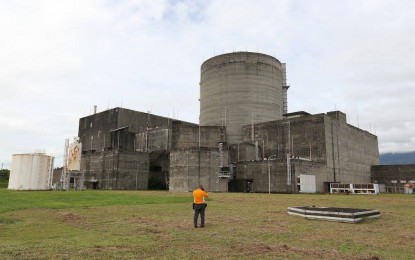
MORE POWER. Addressing the cost and availability of electricity in the Philippines is seen by business leaders as the first major hurdle in attaining upper-middle income economy status. The International Chamber of Commerce’s top local official said several foreign companies have expressed interest in building nuclear power plants that are vastly more modern than the technology used in the mothballed Bataan Nuclear Power Plant seen here. (PNA file photo)
MANILA – The Philippines can achieve upper-middle income economy status by the start of the next decade, given unimpeded economic reforms and sustained fiscal policy support, according to leaders in the business sector and the academe.
They were reacting to a study released by Australia-based ANZ Research projecting that the Philippines would cross the World Bank (WB) threshold for upper-middle-income economies by 2031.
In an interview on Tuesday, Jesus Varela, director general of the International Chamber of Commerce’s Philippine Committee, said he is cautiously optimistic that the seven-year timeframe is attainable as long as the government’s push to promote ease of doing business is sustained.
He also appealed to the Marcos administration to vigorously pursue initiatives that would bring down the cost of power because high electricity rates are a major factor in holding back fresh investments.
Varela said that bureaucratic red tape and expensive electricity may be issues that the incumbent leadership can tackle simultaneously.
“I have been contacted by some Korean investors, and they have expressed their interest in investing in the domestic power sector… particularly nuclear energy. But they are still waiting for the government’s guidance on how to proceed in light of an earlier decision to include nuclear power in the country’s energy mix,” he noted.
For his part, Francis Chua, chair emeritus of the Philippine Chamber of Commerce and Industry, said the pursuit for a higher economic status is exactly why the efforts to amend certain provisions of the constitution have become timely.
He said the proposal to allow foreigners to own larger stakes in local companies should be seriously considered because it will open the doors for more foreign direct investments into the country.
Chua, also the chair of BA Securities, stressed that the Philippines should not limit itself to capital coming from its traditional allies but should also open itself to investments originating from various jurisdictions.
“We should emulate the example set by Singapore. They encourage investments from all over. The President (Ferdinand R. Marcos, Jr.) is doing a good job of inviting new investments from the different countries he visits,” he noted.
Both Chua and Varela pointed out that the recent lowering of corporate income taxes to 25 percent from 33 percent is a good decision that will stimulate more investments, resulting in better job opportunities and consequently, better pay for the Filipino workforce.
Meanwhile, Roberto Galang, Jr., dean at the Ateneo de Manila’s John Gokongwei School of Management, said attaining upper-middle income status in the schedule forecasted by ANZ may be a struggle for the Philippines in view of certain international developments.
He pointed out that the country is facing global economic headwinds, such as the slowdown in many of its trading partners like Japan, China and Germany.
“The (ANZ) report highlights the need to accelerate reforms, such as to allow more foreign investments, reduce red tape, eliminate non-tariff barriers. We also need to capitalize on our selection in the US CHIPS (Creating Helpful Incentives to Produce Semiconductors) Act that provides access to US government funding for semiconductor investment and production. More trade agreements can help us expand our export base, and increase our manufacturing potential -- as these are key in creating high-paying jobs and improving productivity of our economy,” he told the Philippine News Agency.
An upper middle-income country has a gross national income (GNI) per capita range of USD4,466 to USD13,845.
Currently, the WB considers the Philippines a lower middle-income country with a GNI per capita of some USD3,950. (PNA)
